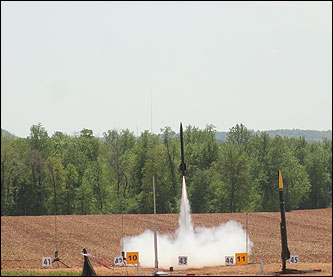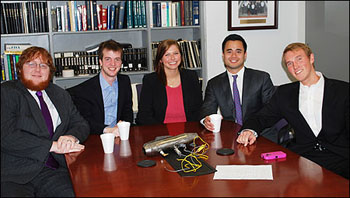
A biohybrid fueled ramjet engine design paid off as a Vanderbilt rocket climbed into blue skies today over an Alabama farm near Huntsville.
For the fourth year in a row the Best Payload Design award went to the Vanderbilt Aerospace Club in the 12th annual NASA University Student Launch Initiative Sunday, April 21, in a field at Bragg Farms in Toney, Ala. This is the sixth year the club has entered the national rocketry competition.

The Initiative presents a challenge of designing and building rockets that will fly to a target altitude of one-mile high (5280 ft) and demonstrate and document the engineering process to build it. Teams submit reviews of a preliminary design, critical design and flight readiness prior to coming to Huntsville. They conduct a launch readiness review before the competition flight. The duration of the competition is about nine months.
The Vanderbilt rocket – Hello Good Bio – flew to a height of 5,326 feet. The team reported that early indications are all systems worked perfectly and the ramjets ignited during flight. Alabama A&M won the Altitude Award by flying 5,269 feet.
There were 56 middle school, high school and university teams that qualified for this year’s event, and 48 teams were able to launch rockets. This year 35 university teams competed, including Georgia Tech, Mississippi State, MIT, Northwestern, Penn State, University of Alabama-Huntsville, University of Illinois, University of Louisville, University of Minnesota, Virginia Tech and University of North Carolina.
The competition was delayed a day due to rain Friday evening. Sunday brought mild temperatures and little wind, perfect for rocket launches.
Innovative payload design

The design of the Aerospace Club’s ramjet engine – tested on the rocket flight – was cited by NASA as the most creative and innovative payload that maximized safety and science value, said faculty adviser Amrutur Anilkumar, professor of the practice of mechanical engineering.
In addition to building a rocket, teams must conduct a science experiment, either with the rocket design or with its payload. “We’re increasingly seeing more complex payloads every year,” said Julie Clift, Student Launch Initiative program manager for NASA’s Marshall Space Flight Center.
The team’s goal was to test the efficacy of biofuels for aerospace use. They used a pair of subsonic ramjet engines powered by a mixture of biodiesel and bioethanol. The biodiesel is produced by the Vanderbilt Alternative Energy Club from used cooking oil provided by the university’s dining halls.
“The bio-hybrid ramjet engines are miniaturized jet engines that use carbon neutral, 100 percent renewable bio-hybrid fuels for combustion. Both engines were flight tested during the competition and were ignited in flight, and sustained combustion for the entire 4.5 second test window,” said Brock Smethills, president of the Aerospace Club.

Smethills thinks the hybrid ramjet engines showed the viability of renewable energy in the aerospace industry. “It opens the door for discussion about replacing traditional jet fuel with more sustainable and environmentally responsible bio-fuels.”
“The aerospace club projects are extremely challenging and require a heavy commitment from the students, but in the end can be very rewarding,” Anilkumar said. “Our students have proven time and again that they can compete and win at the highest levels.”
Mechanical engineering seniors Smethills, Francene Corradetti, treasurer; Justin Langford, design engineer; Jason Lee, design engineer; Ryan Thompson, vice president; and Dexter Watkins, instrumentation specialist, designed the ramjet engine under the guidance of Anilkumar. Robin Midgett, electronics technician in mechanical engineering served as the team rocketry mentor and safety officer.
“This year’s team was particularly detailed at attending to safety and recovery issues and an excellent rocket flight is a testimony to this,”’ said Midgett.
“Beginning day one, our team always considered the payload performance a top goal. We’re honored to be selected for the premier payload design for the fourth time,” said Justin Langford. “Many great universities were represented and it is an unbelievable feeling for all of our work to be recognized.”
Although the work is challenging and time consuming, Jason Lee said it’s rewarding to see the effort pay off. “I definitely felt a great sense of accomplishment watching our rocket take flight, both ramjets ignite, and the recovery system successfully deploy. It’s strange when you realize that an entire year’s work comes down to a few minutes of rocket flight.”
Other team members enjoyed the camaraderie. “The USLI event was a great opportunity to share our enthusiasm with like-minded individuals,” Dexter Walker said.
Outreach with unique twist

As part of the competition, each team is required to present a science, technology, engineering and mathematics (STEM) lesson to middle schoolers.
Vanderbilt’s 2013 outreach event had a unique twist. Lauren Angotti, a former Aerospace Club member, is now a science teacher at Page High School in Franklin, Tenn. Angotti taught her students about engineering design processes using a four-week curriculum for soda bottle rocket design created by a combined team from the Aerospace Club and Peabody’s Department of Teaching and Learning. In 2012 that curriculum earned the club NASA’s outreach award – the Educational Engagement Award.
Angotti taught lessons on basic rocket dynamics, fin number and placement, nosecone shape, and amount of propellant water to be used. The lessons culminated with a rocket launch competition between all the teams in her class. Current members of the Aerospace Club attended the launch day event to assist with the final competition. The Aerospace Club provided the launchers and the field assistance to conduct the competition.
Overall winner in May

A panel of judges, some from Marshall Space Flight Center, will review all entries and announce an overall winner in mid-May.
“During the next two weeks the team will be doing extensive data analysis and submitting a final report to NASA. In the past, Vandrbilt Aerospace Club has consistently placed in the top three, and the team is hopeful that their overall efforts this year will take them farther,” Anilkumar said.
Two awards are voted on by the teams: Best-looking rocket went to University of Nebraska-Lincoln and Lucy Rede Franco Middle School; best team spirit went to Tarleton State University of Stephenville, Texas, and Victory Christian Center High School of Charlotte, N.C.
Other awards are:
- Best vehicle design: University of Louisville
- Best payload design: Vanderbilt University
- Best science directorate payload: Tarleton State College
- Best project review: Mississippi State
- Best website: University of Louisville
- Best education engagement: University of Louisville
The rocketry challenge is managed by Marshall Space Flight Center’s Academic Affairs Office. ATK Aerospace Group of Magna, Utah, provides corporate sponsorship, and the National Association of Rocketry provides technical review and launch support.
“Launch day is a unique monster. The culmination of 9 months’ worth of untold manhours in the machine shop or computer lab is put to the test in a two-minute rocket flight,” Langford said. We quite literally watch our work go up in a puff of smoke and pray for its safe return to the Earth. It is inspiring to see all of the teams who have devoted so much time and have put such care into their rockets all share the same nervousness, eagerness and ecstasy.”